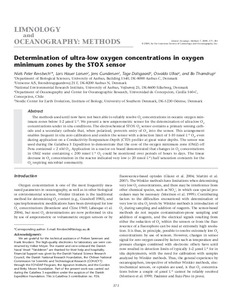| dc.contributor.author | Revsbech, Niels Peter | |
| dc.contributor.author | Larsen, Lars Hauer | |
| dc.contributor.author | Gundersen, Jens | |
| dc.contributor.author | Dalsgaard, Tage | |
| dc.contributor.author | Ulloa, Osvaldo | |
| dc.contributor.author | Thamdrup, Bo | |
| dc.date.accessioned | 2019-05-14T13:29:47Z | |
| dc.date.available | 2019-05-14T13:29:47Z | |
| dc.date.issued | 2009 | |
| dc.identifier.citation | Revsbech, N. P.; Larsen, L. H.; Gundersen, J.; Dalsgaard, T.; Ulloa, O. and Thamdrup, B. ( 2009) Determination of ultra‐low oxygen concentrations in oxygen minimum zones by the STOX sensor. Limnology and Oceanography: Methods, 7, pp.371-381. DOI:10.4319/lom.2009.7.371. | en_US |
| dc.identifier.uri | http://hdl.handle.net/11329/930 | |
| dc.identifier.uri | http://dx.doi.org/10.25607/OBP-471 | |
| dc.description.abstract | The methods used until now have not been able to reliably resolve O2 concentrations in oceanic oxygen minimum zones below 1–2 µmol L−1. We present a new amperometric sensor for the determination of ultra‐low O2 concentrations under in situ conditions. The electrochemical STOX O2 sensor contains a primary sensing cathode and a secondary cathode that, when polarized, prevents entry of O2 into the sensor. This arrangement enables frequent in situ zero calibration and confers the sensor with a detection limit of 1‐10 nmol L−1 O2, even during application on a Conductivity‐Temperature‐Depth (CTD) profiler at great water depths. The sensor was used during the Galathea 3 Expedition to demonstrate that the core of the oxygen minimum zone (OMZ) off Peru contained < 2 nM O2. Application in a reactor on board demonstrated that changes in O2 concentrations in OMZ water containing < 200 nmol L−1 O2 could be monitored over periods of hours to days. The linear decrease in O2 concentration in the reactor indicated very low (< 20 nmol L−1) half saturation constants for the O2 respiring microbial community. | en_US |
| dc.language.iso | en | en_US |
| dc.title | Determination of ultra-low oxygen concentrations in oxygen minimum zones by the STOX sensor. | en_US |
| dc.type | Journal Contribution | en_US |
| dc.description.refereed | Refereed | en_US |
| dc.format.pagerange | pp.371-381 | en_US |
| dc.identifier.doi | https://doi.org/10.4319/lom.2009.7.371 | |
| dc.subject.parameterDiscipline | Parameter Discipline::Chemical oceanography | en_US |
| dc.bibliographicCitation.title | Limnology and Oceanography: Methods | en_US |
| dc.bibliographicCitation.volume | 7 | en_US |
| dc.description.eov | Oxygen | en_US |
| dc.description.maturitylevel | TRL 8 Actual system completed and "mission qualified" through test and demonstration in an operational environment (ground or space) | en_US |
| dc.description.bptype | Standard Operating Procedure | en_US |
| obps.contact.contactemail | Revsbech@biology.au.dk | |
| obps.resourceurl.publisher | https://aslopubs.onlinelibrary.wiley.com/doi/abs/10.4319/lom.2009.7.371 | en_US |
 Repository of community practices in Ocean Research, Applications and Data/Information Management
Repository of community practices in Ocean Research, Applications and Data/Information Management
